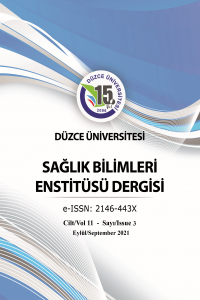Abstract
Amaç: Bruselloz tüm dünyada hala önemli bir halk sağlığı sorunudur. En fazla görülen formu kemik-eklem tutulumudur. Biz bu çalışmada kemik-eklem tutulumu olan ve olmayan bruselloz olgularının epidemiyolojik, klinik, laboratuar ve radyolojik özelliklerini irdeleyip tecrübelerimizi ortaya koymayı planladık.
Gereç ve Yöntemler: Bu retrospektif klinik çalışma, Aralık 2014-Ağustos 2019 tarihleri arasında bruselloz tanısıyla takip edilen toplam 443 hastanın verisini içermektedir. Hastaların epidemiyolojik, klinik, laboratuar ve radyolojik bulguları hasta dosyalarından ve hastane veri tabanından elde edilmiştir. Hastalar kemik-eklem tutulumu olan ve olmayan olarak iki ayrı gruba ayrılıp verileri istatistiksel olarak karşılaştırıldı.
Bulgular: Çalışmaya bruselloz tanısıyla takip edilen toplam 443 hasta dahil edildi. Bu hastaların 92 (%20,8)’si bruselloza ait kemik-eklem (sakroileit, spondilodiskit, artrit, bursit, sinovit) tutulumuna sahipti. Kemik-eklem tutulumu olan hastaların tümünde tanı da manyetik rezonans görüntüleme yöntemi kullanılmıştı. Kemik-eklem tutulumu olan vakalarda şikayet süresi daha uzun, akut faz reaktanları ve aglütinasyon titresi daha yüksekti.
Sonuç: Brusellozda kemik-eklem tutulumu hem tedavi yetersizliğine neden olabileceğinden hem de sekelle sonlanabileceğinden oldukça önemlidir. Kemik ve eklem tutulumunun tanısında radyolojik görüntülemenin önemi büyüktür fakat gereksiz istemlerden de kaçınılmalıdır. Bunun için semptom süresi, akut faz reaktanları, aglütinasyon titresi yol gösterici olabilir.
Supporting Institution
yok
Project Number
yok
References
- 1. Pappas G, Akritidis N, Bosilkovski M, Tsianos E. Brucellosis. N Engl J Med. 2005; 352:2325.
- 2. Pappas G, Papadimitriou P, Akritidis N, Christou L, Tsianos EV. The new global map of human brucellosis. Lancet Infect Dis. 2006; 6(2): 91.
Abstract
Aim: Brucellosis is an important problem all over the world. The most common form is bone-joint involvement. In this study, we planned to reveal our experiences by examining the epidemiological, clinical, laboratory and radiological features of brucellosis cases with and without bone-joint involvement.
Material and Methods: This retrospective clinical study includes the data of 443 patients who were followed up with the diagnosis of brucellosis between December 2014 and August 2019. The epidemiological, clinical, laboratory and radiological findings of the patients were obtained from the patient files and hospital database. Patients were divided into two groups as with and without bone-joint involvement and their data were compared statistically.
Results: A total of 443 patients who were followed up with a diagnosis of brucellosis were included in the study. 92 (20.8%) of these patients had bone-joint involvement of brucellosis (sacroileitis, spondylodiscitis, arthritis, bursitis, synovitis). Magnetic resonance imaging method was used for diagnosis in patients with bone-joint involvement. Patients with bone-joint involvement had longer duration of complaints, and acute phase reactants and agglutination titers were higher.
Conclusion: Bone-joint involvement in brucellosis is very important as it may cause inadequate treatment and may end with sequelae. Radiological imaging is important in the diagnosis of bone-joint involvement, but unnecessary requests should also be avoided. Symptom duration, acute phase reactants, agglutination titer may be guiding for this.
Project Number
yok
References
- 1. Pappas G, Akritidis N, Bosilkovski M, Tsianos E. Brucellosis. N Engl J Med. 2005; 352:2325.
- 2. Pappas G, Papadimitriou P, Akritidis N, Christou L, Tsianos EV. The new global map of human brucellosis. Lancet Infect Dis. 2006; 6(2): 91.
Details
| Primary Language | English |
|---|---|
| Subjects | Health Care Administration |
| Journal Section | Research Articles |
| Authors | |
| Project Number | yok |
| Publication Date | September 20, 2021 |
| Submission Date | February 10, 2021 |
| Published in Issue | Year 2021 Volume: 11 Issue: 3 |



